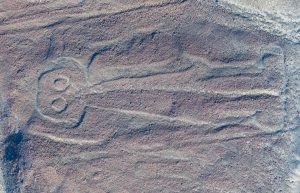Hundreds of New Mysterious Nazca Glyphs Discovered

 In southern Peru’s desert, the Nazca glyphs have long baffled archaeologists. These massive, ancient symbols, etched into the ground hundreds of years ago, can only be fully seen from the sky.
In southern Peru’s desert, the Nazca glyphs have long baffled archaeologists. These massive, ancient symbols, etched into the ground hundreds of years ago, can only be fully seen from the sky.
Since their discovery in the 1940s, around 430 glyphs have been identified across the vast Nazca Pampa.
Recently, a team led by Masato Sakai from Yamagata University in Japan used drones and AI to uncover 303 new glyphs in just six months, nearly doubling the known number.

“The reason why the purpose of the geoglyphs’ creation remained unknown for so long is that previous researchers lacked basic information about the distribution and types of geoglyphs,” Sakai explained.
By clarifying the distribution with advanced technology, they now believe these symbols served a sacred purpose tied to pilgrimages to Cahuachi, a ceremonial center of the Nazca culture.
Uncovering these glyphs has been a challenge, as they were created between 500 BCE and 500 CE and have been weathered by time. The immense size of the Nazca Pampa—400 square kilometers—has also hindered traditional fieldwork. Since 2004, Sakai has relied on remote sensing, discovering 318 glyphs before the latest findings.
By collaborating with the IBM Thomas J. Watson Research Center, the team developed an AI algorithm to detect faint glyphs from drone images. Of the 303 new discoveries, 178 were identified by AI, showcasing its potential to assist in archaeological research.
These newly found glyphs are of the relief type, smaller and harder to spot than the line-type glyphs. Relief-type glyphs often depict humans and animals, while the larger line-type glyphs depict wild creatures.
The team believes the placement and size of the glyphs provide clues to their use, especially in relation to Cahuachi and other ceremonial centers.
Sakai’s next goal is to decipher the information encoded in these ancient symbols.




